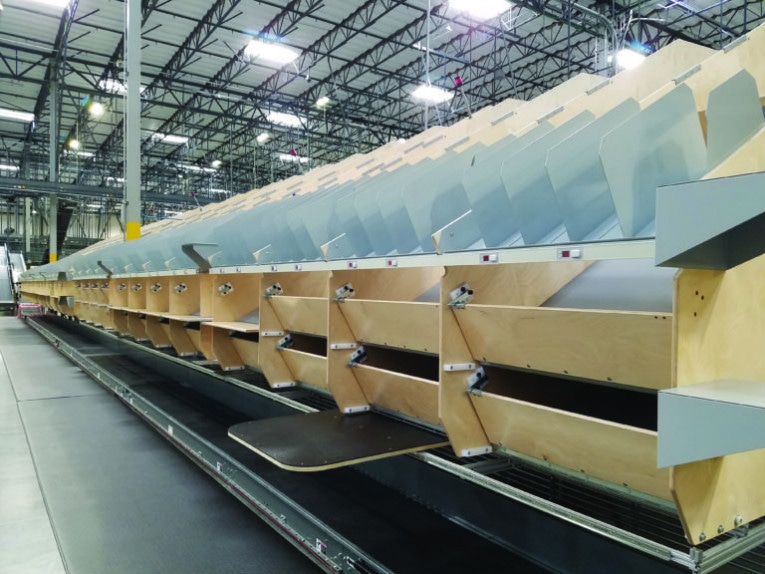An improvement in packaging efficiency required attention to ergonomics, ease of assembly, and cost efficiency.
Automation is changing how traditional distribution centers operate as companies search for new ways to maximize their efficiency, increase order accuracy and fulfill customer demand. When it comes to automated technology, most people tend to think about robots, automated guide vehicles and pick-and-place systems. But just as important are the smaller, simpler structures that must be engineered to interface with the high-tech systems. And their designs present their own set of challenges.
Demonstrating this point, systems integrator FUYU, Inc. recently devised a simple, yet large-scale solution to improve the efficiency of an existing warehouse packaging staging module. Though limited by challenging design constraints, the company created a supporting structure that mounts underneath the existing module and integrates an arrangement of plywood, aluminum extrusions and linear bearings, an achievement that required attention to ergonomics, ease of assembly and cost efficiency.
Engineering challenges
In this recent application, an automated package distribution center was looking to improve its packaging modules. Each module is made up of four chutes that feed packages from the top of the system down to the station operator. The operator is notified of an order and, from there, can pull it out, package it and place it onto a conveyor belt beneath the chutes. The customer wanted to incorporate support platforms onto the design of this existing structure, which the operators could use to box the finished orders.
A few solutions were initially proposed, including a scissor lift, a drop shelf and a motorized, wheeled cart. However, all of these systems would operate apart from the existing module without having to mechanically interface with it. These ideas were ultimately scrapped because they were too costly or had ergonomic problems associated with them, requiring workers, for example, to twist, running the risk of injury.
FUYU ended up solving these issues with a simple design that connects to the module and even uses its existing boltholes. For a work surface, the engineers created tables made of strong ply, which they capped with an ABS plastic. These ABS “tops” were water jet cut and served as the template to rout the tables from the ply. The tables were then mounted onto a linear slider, which was mounted simply into a standard aluminum extrusion.
From there, workers can slide a table along the length of the chutes to where it is needed—a taping station, for example. While there is one table per four modules, tables can travel freely across up to 12 modules, maximizing design flexibility and minimizing the number of tables that need to be installed.
Structural engineering required
The success of FUYU’s solution is owed, in part, to engineers’ flexibility over the course of the design process. For example, it became apparent that the use of a 1 x 1 inch lateral bar would not be able to accommodate the moment loads created by the weight of the packages on the tabletops. A 100 lb package placed at the end of a table would create a 600 lb load on the supporting structure, pulling the bearing out of the rear track. To ensure that the system could hold up to these loads, engineers first ran a finite element analysis (FEA) test to analyze and compare system stress under loads using a 1 x 1 in. and 1 x 2 in. lateral bar. Whereas the 1 x 1 in. bar deflected, engineers discovered that the 1 x 2 in. bar could handle the high loads of the heavy packages. They therefore integrated this new component into their design.
Designed for assembly
FUYU’s solution overcame several design constraints, all of which were dictated by the existing packaging structure. For one, engineers had to figure out a way to attach the tables to the structure without any additional drilling or the use of T-nuts. Besides being more expensive than the aluminum sliders themselves, logistically, incorporating T-nuts would have been a design nightmare. Instead, the engineers designed pre-drilled and tapped bars that, once inserted into the extrusions, readily aligned with the track’s 4,000 existing boltholes.
It was also important that the design maintain a certain height so as not to impede the conveyor belt beneath the staging module once it was attached. FUYU’s solution added only four inches to the vertical space between the module and the conveyor underneath.
Cost savings
Additionally, unlike the motorized, wheeled cart originally proposed, FUYU’s final design included no complex moving parts. It integrated a simple, space-efficient structure that could be attached to the existing staging module using the structural members, bolt holes and brackets from the existing structure for seamless integration—reducing overall implementation costs by 40%.
Post time: May-18-2020








